Advanced Bead Fishing For Salmon: Guide Tactics and Setup
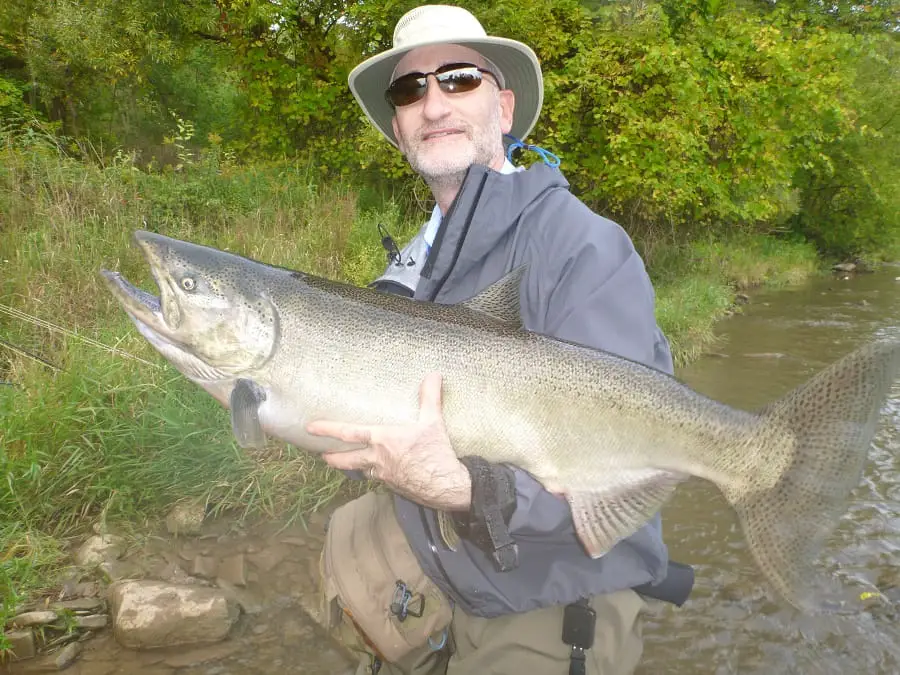
More and more anglers and river guides are revealing that beads are great when salmon fishing in rivers. As a river guide myself, bead fishing for salmon is something I’ve been doing for over ten years, and at times, salmon beads will out-fish other well-known baits.
The reason beads are so effective is that the salmon beads imitate the natural eggs exceptionally well, and since they come in lots of sizes and colors they can match any river conditions.
Anglers who know how to rig beads properly and then fish them well will catch more salmon. I will reveal the best beads for salmon fishing and show you the most effective salmon bead rig.
We may make a small commission from some of the links on this website, which is at no cost to you. I appreciate your support.
Bead Fishing For Salmon: Do Salmon Bite Beads?
If the salmon do grab your bait, it was said they do it out of aggression, instinct, or it’s a habitual strike response.
Recent studies have shown that some salmon that enter the river to spawn will actually feed on eggs, nymphs, and pretty much anything they can.
In the same study, salmon eggs were the primary food found in the bellies of the salmon. The key is knowing where and how to fish salmon once they enter the river and what the best baits for salmon are.
I also know from personal experience that they do feed, and sometimes very aggressively.
Often, I think many salmon get very pressured by all the anglers chucking lures and big roe bags at them, and I have found during these conditions, small and less intrusive baits like flies and beads can be the only thing they will eat.
Which Beads Are Best For Salmon
There are two types of beads that I have found to be very effective for salmon. They are hard beads and soft beads.
Hard Beads For Salmon Fishing
Hard beads are my favorite for many reasons. Hard beads are easy to rig, they stay on the line, and they can take a beating from the rocks and from multiple salmon.
Hard beads can be made from plastic or glass, and the latest I’ve seen are ones made from rocks.
Plastic Beads
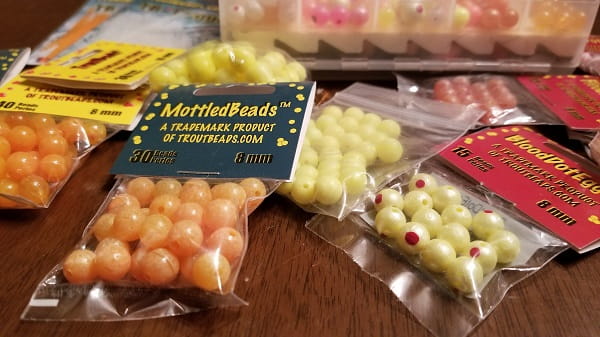
I mostly use the plastic beads because I like their almost neutral buoyancy, which makes them hover off the bottom and move more naturally in the strike zone. They drift in the current, similar to how a natural egg would move.
My favorite brand of plastic trout bead is the Trout Beads brand, which is sold at Bass Pro Shops or FishUSA.com.
Glass Beads And Gemstone Beads
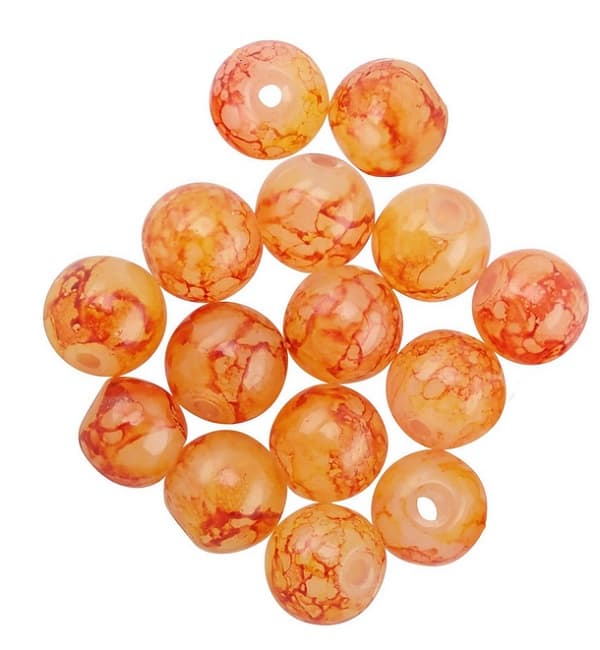
Glass beads and gemstone beads are heavy, and they sink fast and stay down, and because of that, many anglers swear that they are more effective than plastic beads.
I have put plastic and glass beads side by side in the water, and most guys can not tell the difference just by looking at them. I am convinced that the salmon can’t either. What makes guys swear that glass beads are better?
My theory on why glass beads work better for many anglers is simply that the glass beads sink into the strike zone fast, and they stay in the strike zone longer. I also believe that most anglers do not adjust their depths effectively, so since the glass bead will stay much deeper, they get closer to the salmon.
Since I rig my beads a certain way and know how to properly weight my bead setup for maximum results I have not found a difference between glass and plastic beads when it comes to one being more effective.
I also know the rivers that I guide on exceptionally well and have spent years learning the depth of all my spots, therefore I always have my leader length set to the most effective depths which is why I think glass and plastic beads equally well. I teach my clients how to find the proper depth or length of leader, and I know this will help you.
However, not all anglers are as meticulous as I am or think like I do when it comes to their leader and bead setup, which is why a heavier bead would make a difference on a leader with not enough weight or improper length.
The downside to glass and rock beads is that they can drag the bottom too much, which can lead to the beads going under the salmon undetected or getting snagged on rocks more often, and also risking the glass beads breaking from the rocks.
I have yet to see a plastic bead break like the glass ones do.
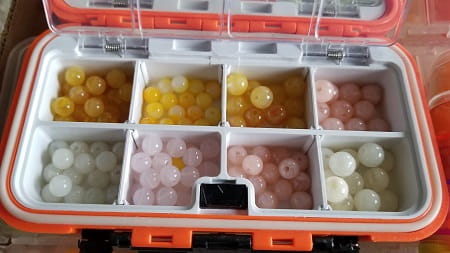
Don’t get me wrong, I think the glass beads are still very good especially if your leader and bead setup is properly done. I also like them because they come in multiple sizes and many great color options that you can’t get in the plastic ones.
My favorite glass beads come from Creek Candy Bead Company.
Fishing Tactics For Hard Beads
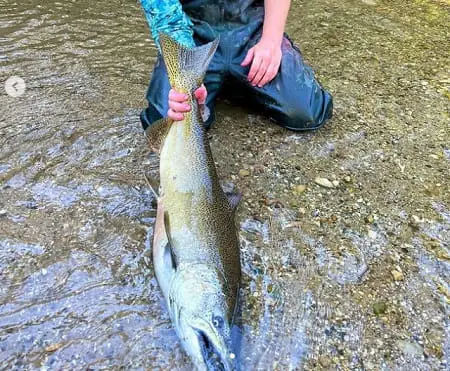
There are two things you should consider if you want to fish with hard beads effectively.
These things stem from the fact that these beads are hard as a rock and have no scent, so when a salmon bites them they will know within a couple of seconds that your bead is not edible.
They will spit beads out fast.
Therefore, you need to set the hook lighting fast, so you do not miss the fish and so you do not give the salmon the opportunity to spit the bead out.
You also need to ensure your angles on your leader are correct. Aggressive trotting, which is also known as checking your float, with beads is a big mistake.
Trotting is a very effective part of float fishing with beads, but only if it is done correctly and for the purpose of controlling the speed of the bait, which, in my opinion, can produce 10 times more salmon.
Soft Beads For Salmon
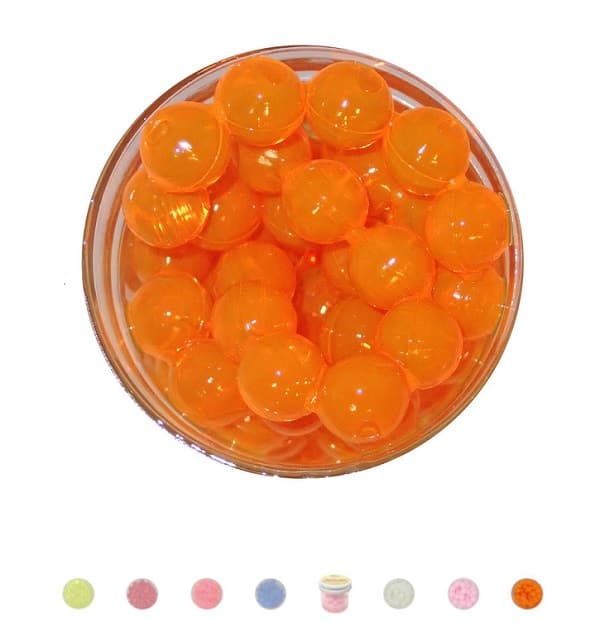
Some anglers are using soft beads for salmon with great success. These soft beads are made from soft rubber or plastic and imitate the look of real eggs.
I don’t use the soft beads very often simply because they are less durable, they fall off the line easier than hard beads, and they are limited in colors.
The upside to soft beads is that they are softer and aren’t likely going to be spit out as quickly as hard beads.
Some of the best soft beads are:
- Berkley Gulp! Alive! Floating Salmon Eggs – get them at FishUSA.com or at Bass Pro Shops – HERE
- Berkley PowerBait Magnum Power Eggs – Get them at FishUSA.com – HERE
- Magic Salmon Eggs – Get them at Bass Pro Shop
- Atlas Lunker Eggs – get them at FishUSA.com
Best Bead Sizes For Salmon
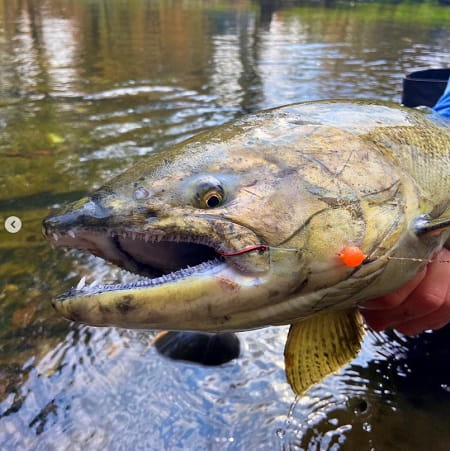
Most beads come in size 8mm, which is about the size of a single salmon egg. Hard beads also come in 6mm which is about the size of a steelhead or trout egg.
Both the 6mm and 8mm beads are good options in low clear water or when trout eggs are present. For most fishing conditions, I have found the 8mm size bead to be best.
Under high water, fast water, or dirty water, larger 10mm and 12mm hard beads are good.
Best Bead Colors For Salmon
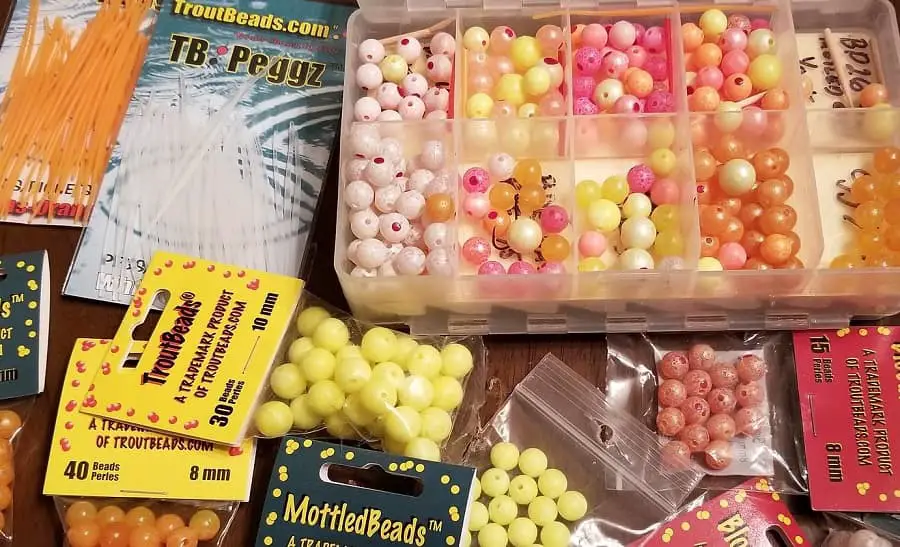
There might be over 100 different colors available if you shop all the different brands of beads.
The best color for salmon is tough to say because on one river, a natural orange color might be best, while on another river, peach, or red might work better.
I have also seen salmon and steelhead switch color preferences as the day progresses. As an example, in the early morning, the salmon might be all over a hot pink, hot orange, or even Chartreuse in the low-light conditions. But later in the day, under bright sun, they will only eat peach, light yellow, or white.
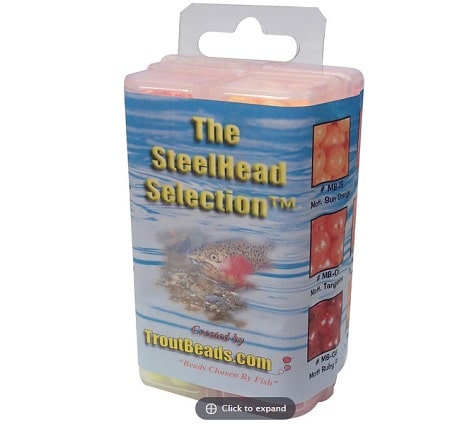
River conditions and water clarity also play a big part in what bead color is best.
In high, dirtier water, I use a larger bead in chartreuse, hot orange, or red because these colors stand out and get more bites for me.
When the water is clear I find that the more natural colors like oranges, yellows, peaches, and soft pinks are the most effective colors.
That is why it’s best to have a variety of different colors on hand to test out what the salmon want. A good selection is the Troutbeads Steelhead Selection or the P-Line Trout Bead Assortment, both available from FishUSA.com.
Check out these bead color charts that I use to determine the best bead color for salmon.
Plastic Bead Color Table:
Clear Water Use: 6mm and 8mm | Medium Clear Water Use: Size 8mm is best | Dirty Water Use: Size 10mm or 12mm |
Peach Roe | Egg Yolk | Chartreuse |
Salmon | Natural Roe | Hot Cherry Roe |
Glow Roe | Orange-Clear | |
Peach Fuzz | Gold Roe | |
Apricot Swirl | Mottled Natural Roe | |
Gold Roe | Pink | |
Milt Roe | Cerise |
Glass Bead Color Table
Clear Water | Medium Clear Water Size: 8mm and 10mm | Dirty Water - 12 inches or less vizability Size: 10mm or 12mm |
Clearwater Candy Corn | Natural Honey | Frosty Chartreuse Hyper UV |
Clearwater Atomic Peach | Tequila Sunrise | Blood Shot Embryo |
Clearwater White Widow Hyper HD UV | Blood Shot Candy Corn | Clearwater Atomic Chartreuse Hyper HD UV |
Frosty Brown Roe Hyper UV | Bow Roe Hyper UV | |
Natural Sucker Egg | Toxic Berry Hyper UV | |
Blood Shot Candy Corn | Trout Crack Hyper UV |
Best Bead Hooks For Salmon
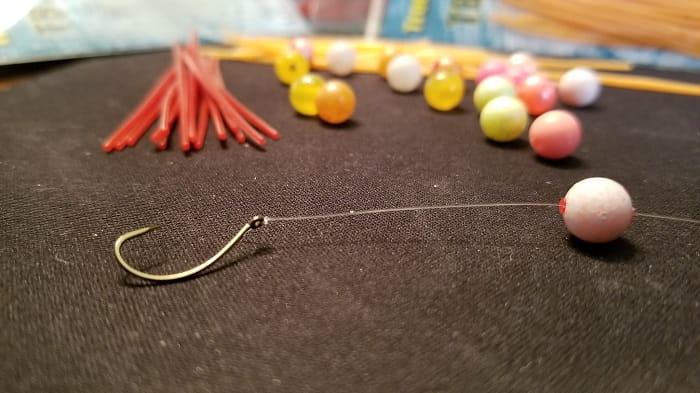
Salmon are big and strong and can bend cheap hooks or thin wire hooks.
For this reason, I use only a couple of tested and proven hooks that work well when salmon fishing with beads.
- Low Clear Water: Raven Specimen Hook in size eight or maybe a size ten on smaller rivers
- High And Fast Water and Large Rivers: Raven Specimen hook or the Daiichi X510 salmon hook in sizes 2 to 8. The bigger the river and the faster the water, or the dirtier the water, the larger the hook size I will use. Many West Coast anglers are using sizes 2 or 4, while Great Lakes anglers are using sizes 6 and 8.
Proper Presentation When Fishing Beads For Salmon
When bead fishing, anglers have the option of float fishing with a spinning reel, a baitcasting reel, or centerpin reels.
You can also effectively fish beads when bottom bouncing or drift fishing.
There are some anglers, myself included that are now fly fishing with beads under an indicator or when Euro Nymphing.
Whatever method you choose, it is very important to present your beads properly. The proper presentation can 10X your results and it’s often the reason why most river guides will catch so many more fish than the average angler.
Salmon Bead Rig
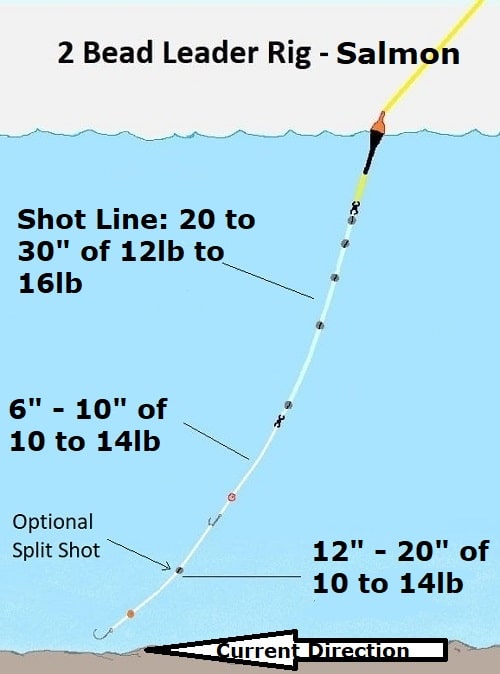
The salmon bead rig that I have found to be the most productive on most rivers is the same as what I use for steelhead.
This rig can be adjusted for multiple depths. You can add more weights and more length as needed.
It is best to keep the bead 1.5″ to 2 inches up from the hook. You can secure the bead to the line with various methods, but most anglers prefer to use what is called bead pegs.
Bead pegs are thin soft plastic or rubber that look similar to a toothpick. They can come in many colors including clear.
FYI, some guys actually use toothpicks. Just push it into the hole to secure the line, snap off the toothpick, then trim off the access.
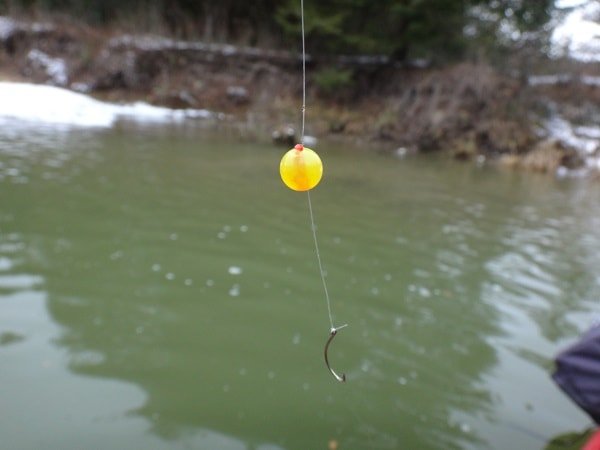
You can see the proper bead placement in this picture. You can also see that this bead was secured to the line using a red bead peg.
Having the hook 1.5″ to 2″ from the bead provides a better hook up, However, in some areas, fishing with a bare hook like this is illegal.
If your state or province does not allow you to use a bare hook, anglers will tie some thread onto the hook so that it’s not bare. I’m not telling you to do this, or that this will make it legal in your area, but this is what anglers and guides are doing to get away with it.
You can see the red bead pegs in the picture below. Each peg can be used two times and trimmed to conceal the peg.
I prefer the TroutBead pegs from FishUSA.com over all other methods for securing beads to the line because they allow the bead to slide down when a fish has it in its mouth for a better hook set.
My other article on Fishing With Beads includes shallow and deep water bead rigs.
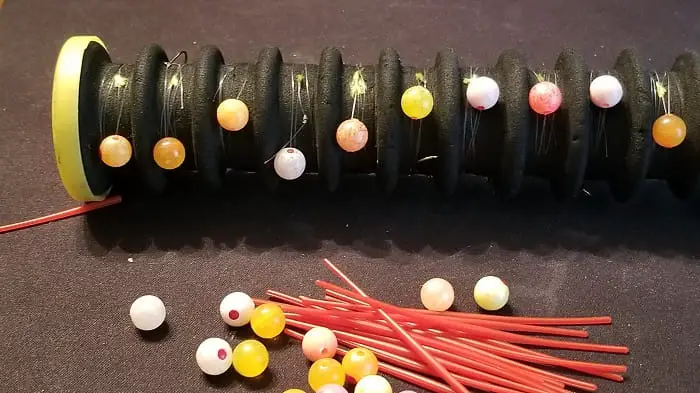
Rigging up your bead on the river can be time-consuming and even difficult with cold, wet hands.
Changing the bead requires cutting off the hook, pulling off the bead, adding a new bead, putting in a bead peg, triming it, and then tying the hook back on.
I pre-rig my salmon beads at home so I can get me and my clients re-tied and back fishing quickly.
Do King Salmon Eat Beads?
Absolutely yes, King salmon do eat beads, and most of the salmon I have caught on beads were king salmon. In fact, I have personally caught King salmon, Coho Salmon, Pink Salmon, and Atlantic salmon using beads.
Do Trout Beads Work For Salmon?
I don’t think there is a whole lot of difference between beads used for trout or the ones labeled trout beads.
In fact, I have used beads found in craft stores with good success, which goes to show you the salmon don’t care as long as the size and color are right, and they are rigged up and fished properly.
How Do You Store Your Salmon Beads?
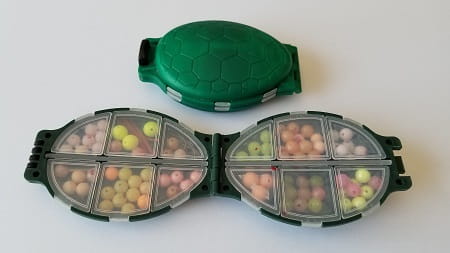
With all my beads, I use small compartment boxes, often known as bead boxes. At home, I have large bead boxes to organize and store my beads. I have smaller pocket-size day boxes that I can easily carry a variety of beads and rigging components.
Tight Lines
Graham

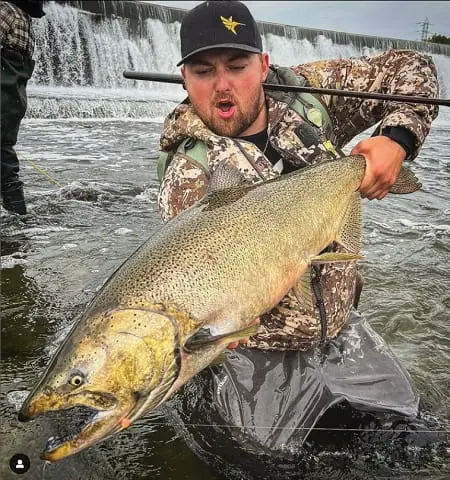
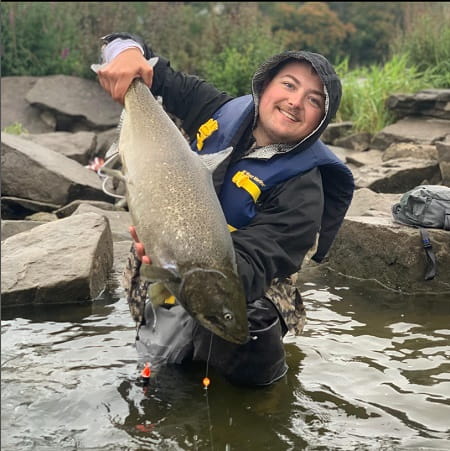
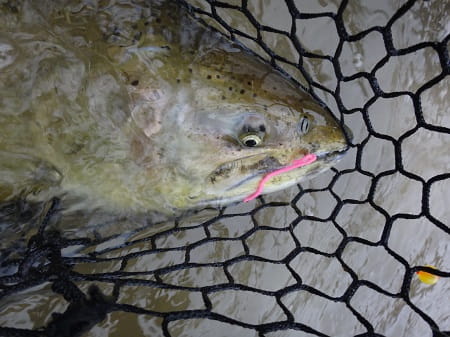
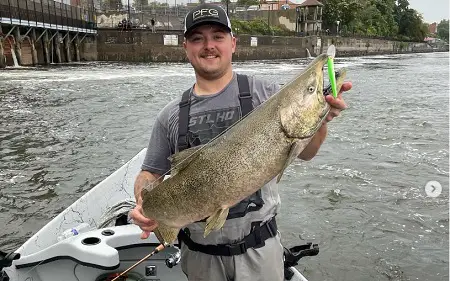
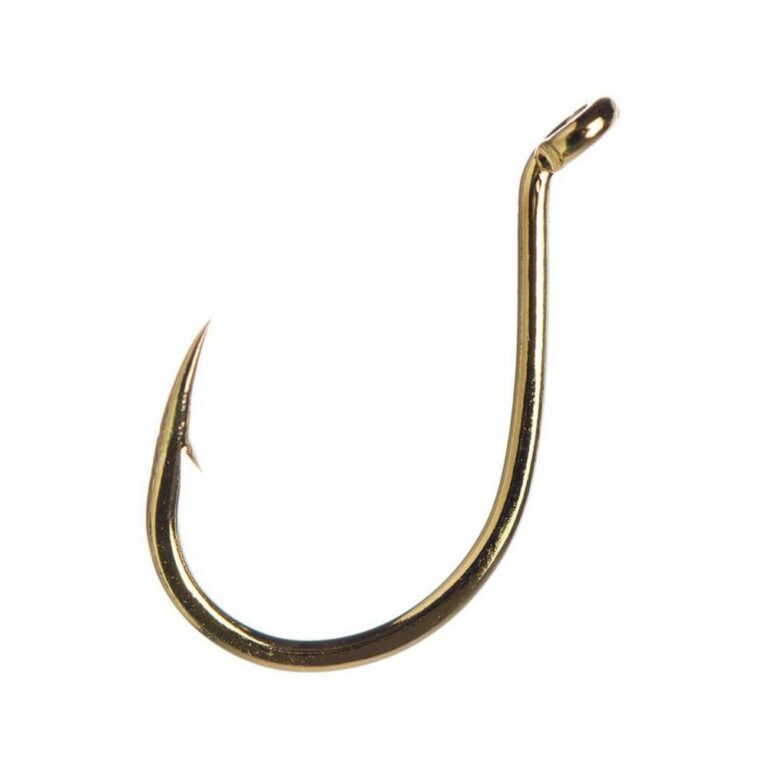
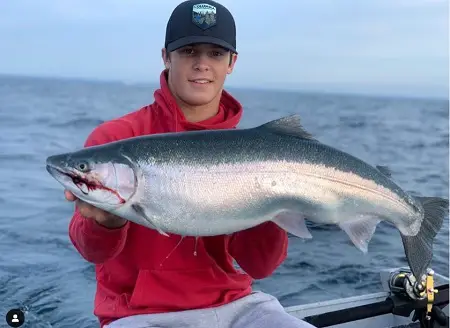
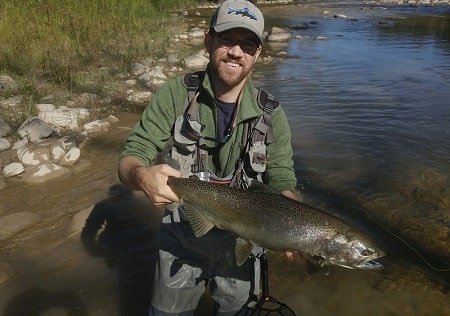
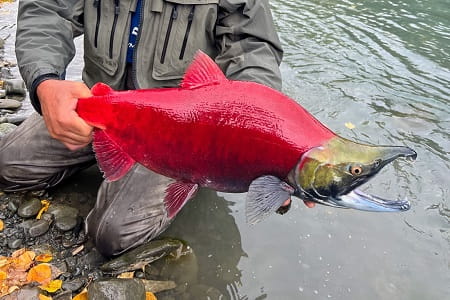
I enjoyed reading this article. Going to try this method out. Thanks for all the important information!
If your bank fishing for KIng Salmon .. Beads are no doubt the most popular method used .. In my over 30 + yrs of Salmon fishing the No Cal Rivers .. a lot , it’s easy to say that probably at least 90% of the fish I’ve caught from AK to Ca have been on beads or Lil Korkies and bead combo with a size #2 Owner Octopus hook tied with a roe knot so the hook hangs straight , We (buddies) used to run 12 lb Trilene Big Game and landed many Kings over 50 lbs .These days I run anywhere from 12/20 lb Yozuri Top Knot or Seaguar ivizx fluorocarbon .. Far as bead sizes , I like 5/6 and 8 mm and I run 3 beads most of the time .. Usually a Chartreuse float bead sandwiched between 2 smaller egg orange beads .. I never bother using many different color combos for Salmon cus It works everyplace I’ve fished … Salmon and especially Kings Love to Hate Chartreuse … they attack it .. better always have this color in your bead box and lots of them , lures whatever bait your using for Kings … gotta have some Chart in it …. Other colors not so much …So if your gonna bead fish Salmon you Specifically want to have plenty of those two colors .. and lil korkies in size 12 ..Chart clown ..I guarantee no matter the water color , clear stained or muddy , weather it’s sunny or cloudy … If the fish are in the river they’ll eat that combo … Steelhead love it too … and for Cohos ..try a hot pink sandwiched by black rondel and .. hold on …
Fish On to y’all
Great info, thanks for sharing.